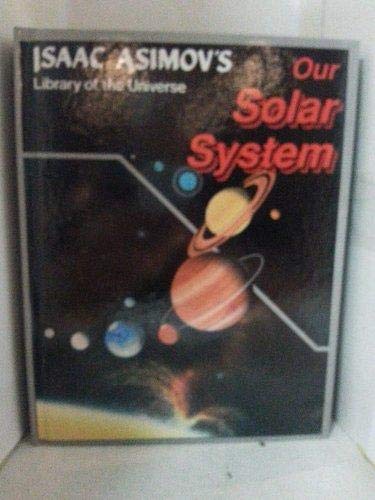-
The Sun and Our Solar System
Jen Green
Paperback (Raintree, Aug. 1, 2017)How do we know that the Sun is at the center of our solar system? This scientific theory is know as heliocentrism. This fascinating book looks at the historical controversies that surround the theory of heliocentrism and tells the stories of the scientists who worked on the theory. It also examines how the theory of heliocentrism was arrived at, how it was tested, and what impact the theory has had on our understanding of science today. X
X
-
Our Solar System
Doctor Merrywood
language (, Nov. 11, 2015)Learn about all eight planets in the solar system!
-
Space!: Our Solar System and Beyond
Peter D. Riley
Paperback (Franklin Watts, March 1, 2012)Discover Space and our Solar System with this book that puts the WOW factor back into science and is packed with investigatations and step-by-step experiments, clearly illustrated with photographs. The book is suitable for young scientists aged 8+.
-
Our Solar System
Peter Riley, Lawrence T. Lorimer
Hardcover (Reader's Digest, Aug. 1, 1998)Demystifies the complexities of space with acetate windows, information bars containing essential facts, photographs, and illustrations that send kids from the Sun to the farthest planets, in this updated edition featuring a bold new cover. R
R
-
Our Solar System
Isaac Asimov
Library Binding (Gareth Stevens, March 15, 1988)NEW-MINT CONDITION-THESE ARE 1ST RUN HARDCOVERS THAT HAVE BEEN STORED TOGETHER AND NEVER OPENED R
R
-
Our Solar System
Giles Sparrow
Library Binding (Enslow Publishers, Jan. 15, 2018)In a mind-bogglingly vast universe, our solar system feels like a comparatively cozy home, perched out on one of the outer arms of the spiral Milky Way galaxy. Formed 4.6 billion years ago from the gravitational collapse of a giant molecular cloud, it is comprised of eight terrestrial and gaseous planets, several hundred dwarf planets, nearly five hundred moons, and other small bodies such as asteroid belts, comets, and dust clouds. Chock full of breathtaking satellite imagery, meticulously detailed computer renderings, diagrams, infographics, and the latest discoveries, readers are treated to a wealth of mind-blowing facts, images, and data. They will gain familiarity with our home solar system while also becoming curious about what lies beyond our threshold in deep space. R
R
-
Our Solar System
Brian Jones, Andrew Gutelle
Hardcover (Smithmark Pub, Sept. 1, 1992)Discusses the planets, asteroids, comets, and meteors that make up the solar system Q
Q
-
The Sun and Our Solar System
Jen Green
Library Binding (Raintree, Aug. 1, 2017)How do we know that the Sun is at the center of our solar system? This scientific theory is know as heliocentrism. This fascinating book looks at the historical controversies that surround the theory of heliocentrism and tells the stories of the scientists who worked on the theory. It also examines how the theory of heliocentrism was arrived at, how it was tested, and what impact the theory has had on our understanding of science today. X
X
-
Our Solar System
Clint Twist
Board book (B.E.S. Publishing, Oct. 1, 2004)Six board books in this colorful set, all shaped to resemble the Sun and its planets, explain the solar system in pictures and text that will appeal to kids. The books in this set, all subtitled Little Book of Facts are as followsMarsUranus, Neptune & PlutoSaturn & JupiterOur SunVenus & MercuryEarth & MoonThe books are handsomely packaged in recessed spaces inside a sturdy cardboard box. The box features additional colorful illustrations of its own on its bottom panel and inside cover, plus a pair of sturdy snaps to keep the lid shut when it�s time for kids to put their books away. The fact books are filled with interesting information. For instance, open the book on Mars and discover that its average temperature is below freezing, and that it�s only about half the size of Earth. Or open the book on the Sun and learn that it�s more than 90 million miles away from us on Earth. Kids discover the rings around some planets, the most spectacular of them being around Saturn. They also learn about the moons that orbit many planets other than our own. Here�s a wonderful introduction to astronomy for boys and girls, and an invitation for them to go outside and study the night sky. R
R
-
Our Solar System
Giles Sparrow
Paperback (Enslow Publishers, Jan. 15, 2018)In a mind-bogglingly vast universe, our solar system feels like a comparatively cozy home, perched out on one of the outer arms of the spiral Milky Way galaxy. Formed 4.6 billion years ago from the gravitational collapse of a giant molecular cloud, it is comprised of eight terrestrial and gaseous planets, several hundred dwarf planets, nearly five hundred moons, and other small bodies such as asteroid belts, comets, and dust clouds. Chock full of breathtaking satellite imagery, meticulously detailed computer renderings, diagrams, infographics, and the latest discoveries, readers are treated to a wealth of mind-blowing facts, images, and data. They will gain familiarity with our home solar system while also becoming curious about what lies beyond our threshold in deep space. L
L
-
Our Solar System
Ian Graham
Paperback (Action Publishing, Jan. 1, 1991)This book provides an original and dramatic introduction to the discovery of space. Through facts, stories and activities, the excitement and fascination of space exploration is freshly conceived for a new generation of young explorers
-
Exploring Beyond Our Solar System
Patricia Hutchison
Library Binding (Momentum, Jan. 1, 2016)Compelling narrative nonfiction text presents the story of the scientists who are exploring beyond our solar system, featuring the intrigue and excitement behind their missions. Additional features to aid comprehension include a table of contents, fact-filled captions and callouts, infographics, a glossary, a listing of source notes, sources for further research, and an introduction to the author. T
T